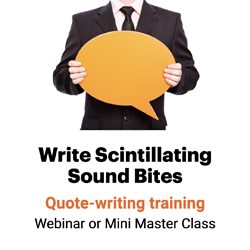Put a quota on quotes
You’ve read the kvetching about overdoing corporate quotes:

“Sprinkling quotes is one thing. Hosing them on is another.”
— John B. Campbell, former senior editor of Business Week
“I think of quotes as spices. Spices in themselves have no nutritional value. They make nutritious things taste better but, like spices, quotes should be used sparingly.”
— Isabel Wilkerson, Pulitzer Prize-winning reporter at The Washington Post
“Too many good ideas are buried in Dilbert-esque releases because … every corporate executive gets quoted.”
— Alison Harris, publisher, Call Center News
You know that quotes slow web visitors down.[1] You’ve read that journalists ranked quotes last — dead last, after even the dateline and the boilerplate — on the list of important elements in a press release, in a 2014 study by Greentarget. You know in your heart that your executive quotes are horrible.
So why do we keep running so many quotes?
Why avoid overquoting?
Writers have heard the benefits of quoting so often, sometimes we believe that quotes are, in themselves, captivating.
Quotes can add credibility to your copy. They can also even make it more colloquial and interesting. But as anyone who’s ever interviewed an engineer knows, the words that spew out of people’s mouths aren’t necessarily intriguing.
Because we’ve been taught to like quotes, writers tend to overquote. But overquoters:
1. Are less picky about choosing quotes. Overquoters use everything — the dull quotes as well as the crisp, compelling ones. That drags the story down. As Jim Ylisela Jr., president and co-owner of Duff Media Partners, counsels:
“Control the blather.”
2. Create a dull rhythm. Talking heads in business communications are as boring as they are on the nightly news. Think how much duller CNN would be if Anderson Cooper just sat at his desk yapping about hurricanes. Like TV news producers, writers need to break up quotes with compelling images and stories.
As Jack Hart, managing editor of The Oregonian, writes in A Writer’s Coach:
“Nothing dulls up a piece of writing like a stream of boring quotations.”
3. Mask the great quotes. Too many dull quotes hide the brilliant gems. Too much of a good thing is almost always a bad thing. Don’t overquote.
How can you avoid overquoting?
1. Put a quota on quotes.
To avoid overquoting:
- Limit quotes to 12% of total word count. That’s the amount of space The New York Times devotes, on average, to quotes. How do we know? We analyzed the quotes in all of the stories, except sports coverage, in a single edition of the paper.
- Follow the one-in-three rule. That is, use no more than one quote every three paragraphs. Better: Use even fewer.
- Don’t be afraid to use no quotes. Some 18% of The New York Times stories we reviewed had no quotes.
2. Paraphrase more often.
In most cases, writers are better at crafting phrases than subject matter experts. So why put all of that original source material, word for word, between quotation marks? Instead or running the original passage verbatim, why not paraphrase and summarize?
That means that in most cases, we should paraphrase the SME.
So never use quotes to just to move facts. That’s what this passage does:
“By following a few simple safety guidelines, you can avoid electrical fires and keep their holidays happy.”
Why quote a subject matter expert quoting a third party to communicate these facts? And then, why quote her some more to make the transition into the tips?
In this case, I’d paraphrase the whole quote and write something more provocative for the subject matter expert to say:
“Christmas is no time to see your family’s dreams go up in flames,” says Somebody at Some Company.
Here are three ways to avoid electrical fires and keep your holidays happy:
So when should you quote? Quote when:
- Someone important says something important.
- Someone says something unique or uniquely.
- You need to:
- Support a new or controversial point that you as the writer don’t have the authority to present credibly
- Communicate opinion, emotion and other things the “reporter” can’t say
- Give your copy a human voice
- Change the pace of the piece
- Add creativity and color to your copy
Otherwise, paraphrase.
3. Curate quotes.
One way to keep your quotes short is to carve out the fascinating bits and paraphrase the bad sentence structure, writing centered on the writer, and the rest. Here’s how The New York Times does it:
Mrs. Cosby, who has been married to Mr. Cosby since 1964, said in a statement that the man portrayed in recent accounts is not the “wonderful husband” whom she still loves.
— “Wife of Bill Cosby Places Fault With News Media”
Tony Isidore of the advertising agency Young & Rubicam persuaded the mayor to admit publicly that he had made mistakes performing the “second toughest job in America.”
— “David Garth, 84, Dies; Consultant Was an Innovator of Political TV Ads”
In March 2011, Mr. Ruqai sought permission to return to Libya with others, referring to the Libyan uprising against Muammar el-Qaddafi and saying they must “move out sooner rather than later” to avoid becoming prisoners of war.
— “U.S. Seeks to Use Letters Found in Bin Laden Raid in Terrorism Trail”
4. Leave quotes out.
Chris Smith, the brilliant copyediting guru at Entergy Corp., offers this technique for reducing the number of quotes in your copy:
“One way to decide whether to include a quote is to temporarily delete it and read the revised piece. Then ask, will a reader learn more if I restore the quote? No? Then leave it out, or find a better one.”
Sometimes a string of quotes can be effective. (Think “My Dinner with Andre.“) But usually, it isn’t. Remember, it’s hard to maintain a line of thought or a narrative flow if you’re constantly trying to squeeze in one more quote.
Jacqui Banaszynski, Pulitzer Prize winner and Knight Chair at the school of journalism at University of Missouri, suggests moving quotes from a web story into a “quote rail,” or sidebar, to get them out of the way.
A PR pro tells her executives: “We’re leaving out the quotes so you can get the comments started.”
Hey: Whatever it takes.
And remember: 18% of New York Times stories have no quotes.
_____
[1] Jacqui Banaszynski, “Newswriting for the Web: Words That Work Online on Deadline,” A Poynter NewsU Webinar, Nov. 18, 2009

Leave a Reply